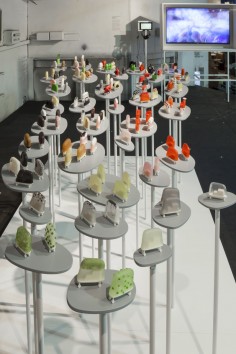Alexandra Daisy Ginsberg
design taxonomy
source: fastcoexist
Although the technology inside cars is beginning to radically change for an electric, self-driven future, car exteriors look pretty much the way they always have. In a new project, a U.K.-based designer imagines how the shell of a car might shift too—from steel and plastic to locally-grown biological materials, changing the way that cars are manufactured, repaired, and recycled.
The project, part of an exhibit up now at the London Design Festival on the future of mobility, considers the idea that the final parts of a car might eventually be made locally, using local materials and adapting to local climates. A company would ship out a chassis, rather than the whole car, and then a local workshop would modify a simple design for the exterior.
In part, the design builds on current attempts to use 3-D printers and other technologies to manufacture locally with nothing but a digital file. “This vision of being able to ship information rather than things is talked about a lot, but is it better? Perhaps,” says designer Alexandra Daisy Ginsberg, a PhD student at the Royal College of Art. “I think it makes it much more interesting if we’re not just shipping globally uniform data to reduce our carbon footprint, but inspiring people to design and make and build and repair locally.”
As people build and repair the cars, the appearance would keep changing, mimicking natural evolution. “I was imagining as you begin to repair a car not to try to take it back to a state production-line perfection, but to make fixes, improve its original design, take on board what the neighbors have done…then you’d start to see diversity expanding as time goes on,” Ginsberg says.
Over the summer, she mocked up a “design taxonomy” of 112 different model cars—it’s all very playful rather than grounded in practicality. “Some of the abstracted ideas I came up with included raincoats, sunshades, hairy insulation, temperature adaptive materials for continental climates and simply drilling holes in your car if you know it’s not going to rain but you want to keep cool,” she says. “The project is not intended as a literal prediction of a desirable future, it’s meant to be a provocation about what we might imagine an ideal system to be.”
She plans to further research materials to see whether natural options could be more sustainable than what car manufacturers use now (arguably a hard task, since steel is both durable and 100% recyclable).
Laminated wood, for example, might be used in some regions, taking advantage of the material’s natural strength and ability to suck in carbon while it grows. “The material might not last as long as steel—which does rust—but it can also be recycled,” she says. “This engineered timber may not be as durable or malleable as steel, but it has other advantages including a far smaller carbon footprint.”
Others are already taking small steps towards alternative materials—in one example, researchers in Brazil are developing a super-strong, lightweight plastic made from pineapples and bananas that could eventually replace parts like bumpers and body panels.
.
.
.
.
.
.
.
source: daisyginsberg
Scientists working in the emerging field of synthetic biology are genetically engineering living organisms to find new ways to produce fuels and materials. Could this change the way we design?
Rather than subjecting biology to design, Design Taxonomy imagines design subjected to biological rules. In this alternative vision for sustainable production, resource-intensive metals and plastics have been replaced by degradable biological materials that can be cheaply and efficiently replaced, whether common materials like wood or yet-to-be invented engineered biomaterials. Car companies no longer produce entire vehicles, but rather manufacture and distribute a durable chassis block, onto which disposable, locally produced bio-shells can be added.
In this scenario, adaptation, mutation and evolutionary patterns would start to emerge. Here, Ginsberg presents a single car, which diversifies down thirteen generations and across five climate zones to produce over one hundred different designs.
.
.
.
.
.
.
.
source: daisyginsberg
Alexandra Daisy Ginsberg is a designer, artist and writer. Seeking new roles for design, Daisy is developing experimental design approaches to help us imagine alternative ideals around technology. Through the design of objects, workshops, and writing and curating, her practice investigates both aesthetic and ethical futures for design. Daisy’s collaborators include scientists, engineers, artists, designers, social scientists, galleries and industry around the world. She began a PhD by practice, The Dream of Better, exploring the idea of a ‘better’ future, at the Royal College of Art in London, in 2013.
As Design Fellow on Synthetic Aesthetics (Stanford University/University of Edinburgh, 2010–2013), Daisy curated an international research project, developing novel modes of collaboration and critical discourse between synthetic biology, art and design. Daisy is lead author on Synthetic Aesthetics: Investigating Synthetic Biology’s Designs on Nature (MIT Press, March 2014). She led the curatorial team for Grow Your Own… Life After Nature, a flagship exhibition about synthetic biology at Science Gallery, Dublin (October 2013–January 2014).
Daisy studied architecture at the University of Cambridge, design at Harvard University and Design Interactions MA at the Royal College of Art. Her work has been exhibited internationally, including MoMA New York, London’s Design Museum, the Art Institute of Chicago, the Israel Museum, the Museum of Contemporary Art, Tokyo and the National Museum of China. Daisy publishes, teaches and lectures internationally: talks include TEDGlobal, PopTech and Design Indaba; she guest-edited Current Opinion in Chemical Biology (December 2012). In 2011, her collaborative work E. chromi was nominated for Designs of The Year and the Index Awards and was collected by the new Museo Delle Scienze in Trento. Daisy won the 2011 World Technology Award for Design and received the first London Design Medal for Emerging Talent in 2012.
Daisy leads Studio Alexandra Daisy Ginsberg Ltd.


